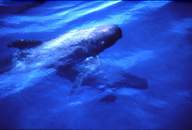|
How do we see bacteria (10/2004)
Understanding how the body’s immune system recognises and responds to microorganisms can be a major step in the development of new therapies against infectious diseases. Towards this aim, a paper just released in the October issue of Embo reports1 discusses the process used by mammals to respond to bacteria such asHelicobacter pylori, Listeria monocytogenes and Streptococcus pneumoniae which are responsible for ulcers, Listeriosis and pneumonia, respectively.
In order to protect against infection it is necessary to detect invading microorganisms/ microbes capable of inducing disease. This is done through the recognition by the immune system of molecules unique to these invading organisms. In bacteria for example, components of their cell walls such as peptidoglycan, a polymer of sugars and peptides which is involved in cells shape and wall integrity, is one such target. The innate immune system is the first line of defence as it can be mobilised almost immediately and have a crucial role in prevention of infection. But the molecules/receptors and the mechanism involved in the recognition and clearance of microrganisms by this part of the immune system are still poorly known. Toll-like receptors (TLRs) are a family of molecules, which have recently emerged as key components in the recognition of infectious agents by the innate immune system.
Now, Leonardo Travassos and Ivo G. Boneca from the Institute Pasteur, Paris, France together with colleagues from the Federal University of the Rio de Janeiro, Rio de Janeiro, Brasil and the University Paris-Sud, in Orsay, France, found that TLR2, a member of the TRL family seems to recognise lipoteichoic acid (LTA) an important component of the bacteria cell wall, but does not recognize peptidoglycans, a result in clear disagreement with previous work by other groups. The differences found are due, according to Travassos, Boneca and colleagues, to contamination of the bacteria used in earlier research.
Before Travassos, Boneca and colleagues’ work it was believed that peptidoglycans were recognised through two different type of receptors; TRL2, which is present on the surface of cells of the immune system and by a family of molecules found in the intracellular space called nucleotide-binding oligomerization domain (NOD) a redundancy of roles that did not make much sense. What the team of scientists’ results show is that in fact the immune system uses these two recognition systems to target different molecules on the bacteria wall, the recognition mechanisms probably acting synergistically and so leading to a more powerful immune response and higher probability of getting rid of infection.
These are important results as detailed knowledge of the molecules and pathways involved in the control of the immune system during infection and inflammation opens the door to new highly selective therapeutics. Furthermore, the discovery that TRL2 seems to recognise LTA is extremely interesting as LTA only exists in the cell wall of Gram-positive bacteria (so called because they become positively coloured with Gram stain) and the initial steps of the innate immune response against this type of bacteria are still poorly understood. This is of great significance as Gram-positive bacteria are extremely important in clinical infections, for example, just in America, two Gram-positive bacteria -Pneumococcus and Staphylococcus - are responsible for almost 75% of all the antibiotic usage.

1 Embo reports (2004); Vol. 5 (10), pp. 1535-1538
“Toll-like receptor 2-dependent bacterial sensing does not occur via peptidoglycan recognition”
Original paper’s authors
288 emails sent
|
In collaboration with the Observatório da Ciência e do Ensino Superior (OCES)
Financed by the Fundação para a Ciência e Tecnologia (FCT) |





